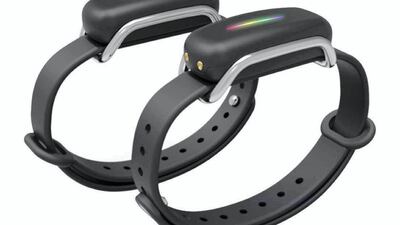Does the internet bring us closer together? Or does it simulate real-world connections in an inauthentic way? It's a question that's long been debated. There's no doubt digital connectivity has given us many forms of communication, from text to emoji, from photo streams to video calling.
But all these developments are, in a sense, making up for the lack of something. One of the biggest absences in modern communication is touch, something that establishes the idea of presence, something we can physically feel. For more than 20 years, scientists have explored the idea that physical sensations can be transmitted across the internet. And yet with sight and sound so dominant in online culture, touch – that most human of senses – is often overlooked.
An example of virtual touch in its simplest form is the Bond Touch, a pair of electronic bracelets worn by couples who are apart but wish to maintain a physical connection. If you tap one, it creates a vibration on the other. They've been around for years, with an initial attempt at crowdfunding made in 2013, but their recent appearance on the wrists of a celebrity couple (namely Shawn Mendes and Camila Cabello) has caused a buzz of interest among long-distance lovers for whom a nightly Skype isn't enough.
"It's a more intimate form of communication, more immediate," says David Parisi, author of Archaeologies of Touch. "And as its proponents like to point out, it's discreet. You can have this message relayed to you – and only to you – via a bracelet or a ring."
One of the first proposals for transmitting tactile information across the internet was made as long ago as 1997. A device called inTouch, which worked in a broadly similar way to the Bond bracelets. But it didn't take long for the idea of remote touch to be scaled up to remote hug.
Professor Adrian Cheok, a leading expert on the multisensory internet, developed the Huggy Pajama, smart clothing that could provide a gentle, remotely triggered squeeze to the wearer. Similar propositions flowed from various research projects – the Hug Shirt, Hug Me, Like-a-Hug and Parihug – all of them with a similar aim: to bring a sense of attachment and affection to a medium that, while connecting the world, doesn't necessarily do so in an intimate way.
"I think about it as a compensatory technology, one that fills a lack in this mode of communication," Parisi says. "If you read about the history of touch interfaces, they frame it in exactly this way. First we had images and sound, and now we're going to add touch – and it's going to be transformative, right?"
Thus far, it hasn't been. Squeezing body suits, in particular, seem to be more about proof of concept than having any practical application. But one area where touch has quietly advanced and been introduced to our gadgets is haptic feedback – vibrations in smartphones and tablets that help us to feel that a button has been clicked, a cursor moved, a message sent.
Parisi says these have communicative possibilities that have been underused. "In the Apple Watch there's a vibration motor that can send fairly complicated touch sensations to someone else wearing an Apple Watch," he says. "The question is the extent to which people value it. Is it something you might try out a couple of times, or something you don't ever use? The companies working on this stuff are struggling with this question."
There's no doubt that on a sensory level our desire for touch is real. Simple sensations can reassure us, calm us and support us in a way that words – either spoken or written – cannot. While a device like Bond Touch isn't capable of conveying complex sensory information, it would seem that the nature of the virtual squeeze isn't necessarily important; it's the gesture that counts.
The sending and receipt of the vibration establishes awareness; it’s a reminder that you both exist and that there’s a connection between you. But thanks to the human imagination, that vibration tends to be attributed with a much deeper level of meaning.
Scientist Jofish Kaye established this in 2006 with an experiment titled Virtual Intimate Object. It was simply a small disc on the taskbar of two computers. A single click would turn the partner's disc red, which would then slowly fade out. But for the people using it, it wasn't only a red disc. It conveyed significance and affection. In some ways it's analogous to the "squillo", the Italian word for the single telephone ring that people make to let the recipient know they're being thought about.
"This question of assigning meaning and association to vibrations is a very personal process," Parisi says. "The technology might work in one way in the designers' imagination, but once it gets out into the wild they don't really know what people are going to do with it."
Judging by our current use of haptic technology, perhaps we aren't sure what to make of it. IBM predicted in 2013 that we would, by now, be able to feel textures through our phones. That hasn't happened, but a great deal of work is ongoing in the field. Scientists evidently feel that we need it, but is it really the case that the modern world deprives us of touch sensations?
"As a historian of ideas, I don't know how valid the claim is," Parisi says. "The same idea dates at least back to the 1960s and I would question how unique this problem is to our age. But haptic technology certainly gets framed as a solution to this problem and feeds into the idea there is some sort of crisis of touch that needs to be responded to."
When we eventually wake up to that crisis, the world of technology will be ready.

